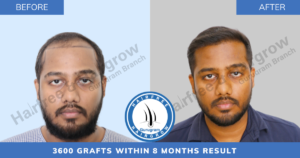Traction Alopecia
What is Traction Alopecia?

Traction Alopecia is a form of acquired hair loss that results from prolonged or repetitive tension to the scalp hair. It was first described in 1907 in patients hailing from Greenland who had been diagnosed with hair loss after wearing hair in tight ponytails for longer periods.
Traction alopecia is a form of hair loss in which mechanical damage to the hair follicle is caused by repeated tension or pulling. Ballerinas, gymnasts, military personnel and certain professionals who are required to wear their hair pulled back, may develop traction alopecia.
When your hair is pulled for prolonged periods it starts getting loose from the follicles and eventually breaks and falls off. The hair follicles are subjected to constant pulling, they get more and more damaged and scarred that they are no longer able to produce any new hair.
This issue can develop due to:
1. Regularly wearing your hair in tight ponytails, buns, braids, dreadlocks.
2. Using relaxers and rollers on hair.
3. Having longer beard and hair and twisting and braiding it, increases its weight and causes submandibular traction alopecia.
The likelihood of traction alopecia increases with age and also from what age you started to put pressure on your hair. There are different phases in this type of hair fall and only getting a consultancy from the best hair transplant clinic in India will provide you with the best solution.
Traction Alopecia has several stages:
A. Early stages: There is hair thinning and you begin to notice a slow but gradual change in the hair growth cycle, as well as an increase in the amount of Telogen (resting) hair. .
B. Subsequent stages: Sebaceous glands and terminable hair follicles diminish and are replaced by fibrous tracts (scars). Inflammation is minimal to non-existent.
Minoxidil, hair transplantation, and topical antifungal shampoos can all help. However, Hair-Free Hair Grow guarantees the best Hair Regrowth guarantee with any technique you and our doctors choose.
Causes Of Traction Alopecia
1. A few hairstyles, such as cornrows, dreadlocks, braids, and tight ponytails.
2. hair weaves or extensions the tension at the hair roots may result from extensions being bonded or tightly knotted to the base of the hair.
3. Where the headwear makes contact with the hair, such as with sports helmets or tight elastic headbands, the hair may begin to thin.
4. Hair ornaments, such as grips or slides that are worn consistently throughout the day.
5. The weight of very long hair may tug on the hair follicles. Tightly knotted beards or extremely long beards can also cause traction alopecia.
6. chemical treatments like hair relaxers. These cause the hair shaft’s structure to change in a way that increases the likelihood of hair loss.
7. combining extensions with relaxers. This was the most significant risk factor for traction alopecia, according to one studyTrusted Source.
Treatment Of Traction Alopecia
If as all possible, avoid tight haircuts. If a person’s occupation or religion dictates that they wear their hair up or in tight buns, they should tie their hair as loosely as possible and wear it down or loose as often as feasible.
Limit your exposure to chemicals, including relaxants. A relaxer should not be applied to relaxed hair. To avoid putting undue stress on one part of the scalp, switch up your hairstyle every few weeks.
Look into hair-growth products. After three to six months of using a minoxidil treatment, about 40% of users begin to experience some hair growth again.
Rogaine has been approved by the Food and Drug Administration (FDA) of the United States, however users should avoid using it if their scalp is irritated or red. Utilize pain relievers. Steroid creams help lessen the traction alopecia-related edoema of the scalp.
Prevention Of Traction Alopecia
1. If you have a painful hairdo, loosen it or modify it.
2. Wear thick, loose braids rather than short, tight braids and switch up your hairstyles every few weeks.
3. Swap the elastic hair ties for cloth ones.
4. Keep your hair as loose as you can.
Hair Loss
⦿ About Hair Loss
⦿ Male Hair Loss
⦿ Female Hair Loss
⦿ Androgenetic Alopecia
⦿ Alopecia Areata
⦿ Traction Alopecia
⦿ Anagen Effluvium
⦿ Telogen Effluvium
⦿ Cicatricial Alopecia
⦿ Folliculitis
Before and After








